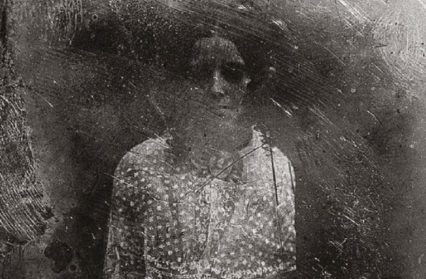In Docklands: A Ghost Story, Damian Walford Davies follows up his two previous collections from Seren – Witch and Judas – with another book-length narrative in verse, this time a ghost story flitting between the luxury and poverty of Victorian Cardiff. Witch, set in the seventeenth century, imagined a Suffolk village torn apart by the hysteria of witch trials; Judas let the Biblical traitor adrift among the squaddies and barflies of present-day Jerusalem, an outcast twice-lost. Docklands appears based upon similarly painstaking research, although the story is fiction. Its protagonist is a prominent but unnamed architect, commissioned to design an elegant square on a patch of dockland slums. In an effort to distance himself from his wife, who is gripped by grief following the death of their infant child, the architect consoles himself in the seedy pleasures of the docks, until he notices a girl appear:
through the whiskey’s umber,
fractured by the lead-glasstumbler’s cuts: ten, or younger…
(‘Solus’)
Grey, bruised, and silent at first, the girl becomes an obsession, drawing ever-nearer to the architect as she follows him through the streets.
As with Witch and Judas, there is a supernatural or spiritual element to the story, but this otherworldly intrusion is not quite as convincing as the material detail of time and place. Walford Davies pins open the precarious world of the docks, where the architect wanders the terraces he must demolish and encounters a world scarcely firmer than the sea it abuts:
… crazy
Angeline and Adelaide, held up only
by the rigging of the washing lines.
(‘Commission’)
Conversation is interrupted by ‘the sounding of a two-tone channel buoy’ (‘Recipe’); after the demolition of the slum terraces, the reader’s eyes almost feel the irritation of the resulting dustcloud:
… its tang –
now sweet, now acrid –
conjured last night’s stagedsaltpetre smoke that veiled
the cheap illusionist’s hey prestos…(‘Wives’)
The poems, each of which consists of eight couplets, all follow a similar quick, staccato rhythm, hanging on careful rungs of rhyme and half-rhyme. Walford Davies has a sharp turn of phrase, paring each observation down to its essence, an almost surgical technique which gives the poetry both its precision and also its slight callousness of tone. Scenes of horror and hope are described in equally clipped fashion, from the amputation of a leg in a dockside pub:
… From nowhere,
someone set to work:
knifestrokes, sawstrokes, reef knotto the artery…
(‘Saw’)
to a moment of reconciliation between the architect and his wife:
… As if along
a corridor of long-barred doors,she tacked towards me,
the lamp behind hermoving in and out of curt
eclipse.(‘Cross-section’)
The book is a monologue in the architect’s voice, which is one reason for the unwavering tone and pace. The rigid structure of the poems is another. The narrator remains a man of confidence and certainty: even as he accepts the presence of the ghost, he never loses control of the pattern of his speech or thought.
The twenty-first century reader might infer a psychological aspect to the haunting: having something to do with the loss of the architect’s own child, and with his resentment of his wife’s grief. Perhaps he has transferred to the girl the compassion he is unable to grant his wife, or himself. To the architect, however, the ghost is real: he asks around to discover her identity, that of a child murdered a few years before. But despite this stimulation of his sympathy, and despite the movement towards reconciliation between husband and wife somehow engendered by the ghost girl, there is not truly a sense in the poems that the architect has changed the way he sees or understands the world. We witness a change in his actions towards the end of the book – he buys a gift for his wife, and replaces the bawdy mermaid which first topped the fountain in his square with a monument to the murdered girl – but little shift in his voice or his composure. This is still a man who knows exactly what to do.
Docklands is, then, a buttoned-up kind of ghost story. However, even if the protagonist’s perspective remains constant, the impact of the book lies in its ability to affect the reader’s view. One of the most vivid images is a scene on St Mary’s Street which holds no particular dramatic function but is perfect in its crystallisation of a moment:
… Woken by the sun,
O’Driscoll shifted in his oilskin
at the cab-stand; his bowlerheld the morning’s downpour
in its rim. I rapped the pane;he raised his face; the bright ring
sluiced off in a flashing plait.(‘Figure’)
Cardiff today is filled with images of its history, on the walls of every pub and café, but descriptions such as these bring the past to life in a way which photographs fail to do. In these poems we taste, smell and hear the city, and we see the shadows behind the grandiose civic architecture of the British Empire. In the tiny details of smoke on a conjurer’s stage, or rainwater falling from a hat, we are immersed in moments quickly forgotten by those who experienced them, but which cumulatively make up the substance of their lives. Docklands is a meticulous study of place, time and atmosphere, which opens the reader’s eyes to a city behind the city, and to lives behind our own.
Docklands: A Ghost Story by Damian Walford Davies is available now from Seren.











